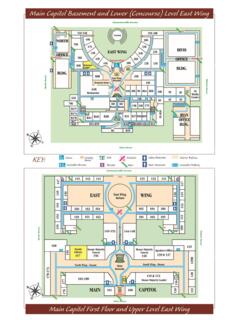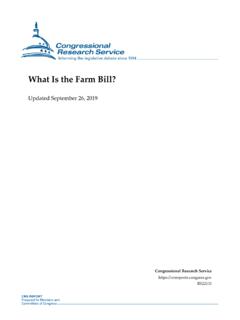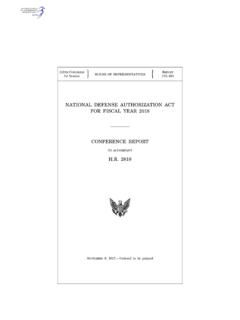Transcription of Making Law PA - Ordered
1 Making LawPennsylvaniaLEGISLATION IN THE PA HOUSE OF REPRESENTATIVESCOMMONWEALTH OF PENNSYLVANIA HOUSE OF REPRESENTATIVESHave you ever wished that government would just step in and pass a law to correct some situation you find totally unacceptable? Fortunately for all of us, it s not that simple. Making law in Pennsylvania is a meticulous process and for good reason. State laws influence our environment, economy, education, our families, our health, and virtually every aspect of our daily lives, now and for generations to come. To make new laws or change those already on the books, lawmakers follow time-honored constitutional procedures.
2 On the following pages, you ll see how a legislative system developed centuries ago still works today, both for lawmakers and the Pennsylvanians who send them to Harrisburg. Then, the next time you wish your legislators would just lay down the law, you ll have a good idea of what it takes to make that There oughta be a law! Making lawHave you ever wished that government woand pass a law to correct some situation yot bl ? Ftt l fll fit responsibilitydable3 Imagine studying thousands of subjects and developing an informed opinion about each one. That is exactly what legislators in the Pennsylvania General Assembly do every term as they consider and vote on proposals that may become law for all Pennsylvania citizens.
3 State representatives and senators perform other services for those who elect them to office, but none are more important than lawmaking. There are many steps in the legislative process, and it can look complex on the surface. Actually, the sequence of turning a good idea into law is quite straightforward, moving in deliberate steps, but at a cautious pace. The founders of our state planned it that way. As former subjects of a king, they knew that a fair society is impossible when a single group or individual can act without restraint to make law for everyone else. They were determined that no one would have the power to create law alone or on impulse and they filled the Pennsylvania Constitution with safeguards to prevent it.
4 Thanks to the vision of our first legislators, Making law in Pennsylvania today requires responsible collaboration by many individuals elected to represent the interests of thousands Balance of PowerThe Pennsylvania Constitution placed a fundamental check on legislative power by creating two bodies which must cooperate to make law the House of Representatives and the Senate. Together, they form the General Assembly, with 50 legislators in the Senate and 203 Representatives in the House. Each body must approve the lawmaking actions of the other or else work out compromises through amendments to proposed laws. Even then, the General Assembly can enact law only with the participation of the Governor, who heads the Executive Branch.
5 The Governor can reject a proposed law by using a veto; however, the General Assembly can override the veto if it has enough votes. In this way, power is evenly distributed, or balanced, between the House and the Senate and between the General Assembly and the Executive Branch. These constitutional safeguards are some of the famous checks and balances you probably first learned about in s the Boss?You are. Along with every Pennsylvanian represented by a legislator. According to the Constitution, the people of Pennsylvania select representatives and senators to act on our behalf with the condition that they answer directly to the citizens who elected them.
6 That happens in the voting booth. Exercising control through our votes is another check on runaway power. Legislators must earn our approval while in office two-year terms for representatives, four year for state senators. During that period, we expect them to represent our best interests every time they consider a proposed law. How well legislators meet our expectations determines whether they remain in office at the end of their terms or are replaced by candidates who voters believe will do a better to specific portions of a proposed law. Amendments may be offered in committees or on the House OF REPRESENTATIVESGENERAL ASSEMBLYEXECUTIVE BRANCHSENATEA bill is the written version of an idea which legisla-tors consider as a new law or a change to an existing law.
7 From its first appear-ance in print, every House or Senate bill travels the same precarious course to the moment it becomes law or goes down to the agony of defeat. On the next few pages, we ll examine that course and it s optional twists and turns as we fol-low the life cycle of fictional House bill unit of lawmaking is the bill . The Life Cycle416bioBirth of a BillThe idea for bill 652 came from a group of Pennsylvania legislators committed to environmental the NestHouse bill 652 moves to the Senate where it is examined in committee, in caucus, and by members on the Senate Floor. The Senate passes the bill without experts at the Legislative Reference Bureau write the proposal in the proper form for a Third Day of ConsiderationMembers actively debate House bill 652.
8 Ultimately, they vote for its Second Day of ConsiderationThe number and title of bill 652 are again read to the members, who continue to prepare for discussion of the bill . Amendments may be offered at this Fictional House bill 652of a bill5graphyThe Chief Clerk names the new proposal by assigning it a Speaker of the House signs House bill 652 on the House Floor and the President Pro Tempore of the Senate signs it in the First Day of ConsiderationBill 652 debuts on the House Floor with an announcement by the clerk from the podium that the bill has been reported from committee. Members begin to inform themselves about the Speaker assigns the bill to a Standing Committee.
9 At the same time, the new bill is copied and distributed to House members and made available to the the TeamHouse bill 652 officially becomes law and is given an Act Final InterviewThe bill arrives on the Governor s desk where the Governor signs it into a Wider WorldLike all bills, 652 is considered by members on the House Floor on three separate of PassageHouse bill 652 is examined by the Standing Committee on Environmental Resources and Energy, which votes to accept it as written and reports it to the House Floor. But first, the topic takes a brief detour into the caucus room for a second round of ReviewMajority and minority party members meet in separate caucus rooms.
10 There, they review the content of House bill 652 and decide whether to support or oppose it, as well as other bills scheduled for discussion on the House CaucusMinority Caucus6 The idea for bill 652 could have come from almost anywhere individual legislators, private citizens or organizations, the Governor, or from bills considered in the past. Ideas for laws can be sparked by federal government regulations or some ruling of the courts. Our sample House bill 652 was proposed, or sponsored, by a group of representatives who share an interest in environmental issues. The legislators sponsoring the idea send their proposal to the Legislative Reference Bureau, where it is written in the proper format by legal experts, copied, and placed in the blue folders known as bluebacks.



